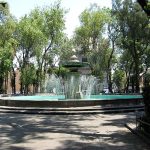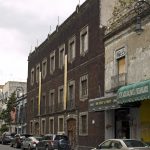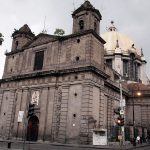

Foto: Daniel Villalobos Peña on Wikimedia Commons
Santa Teresa la Nueva es un ex convento en el Centro Histórico fundado a principios del siglo XVIII. Comúnmente se refieren a él como “la nueva” para diferenciarlo de Santa Teresa la Antigua. Fue construido por el arquitecto Pedro de Arrieta y es reconocido por su puerta que separa la iglesia del convento. El convento fue fundado para cuidar de jóvenes que no tenían suficientes recursos para la dote nupcial. Como monjas, eran conocidas por producir escapularios de la Virgen del Carmen.

El templo está orientado al poniente de Plaza Loreto. Originalmente era más grande y se extendía al oriente, sin embargo, muchas de estas estructuras fueron subdivididas, vendidas o se perdieron. Arrieta concluyó la obra en 1715. Mucho de su estilo barroco original se perdió en renovaciones. En la actualidad, los exteriores e interiores muestran una mezcla de estilos manierista y neoclásico.
Con las reformas religiosas del siglo XIX, el convento pasó a manos del gobierno de la ciudad. En 1866, el gobernador Ignacio Trigueros lo convirtió en la escuela municipal para sordo mudos y en 1870 se transformó, y sigue siendo, la escuela nacional par
 Manuela Molina decidió invertir la fortuna heredada en construir otro convento para mujeres que profesaran la regla de santa Teresa de Ávila, dedicó la fundación a San José. El templo actual ha perdido los retablos barrocos pero conserva pinturas y esculturas de su viejo pasado, en retablos blancos propios del estilo neoclásico. En el espacio destinado para coro bajo, se inventó una gruta, desvirtuando su sentido original, aún conserva la reja de hierro y algunas púas que impedían el contacto entre las profesas y el público que asistía al templo. En la iglesia se encuentra a la devoción pública el corposanto de Santa Celeste mártir. Este tipo de esculturas en cera fueron elaboradas en Italia y constituyeron un gran mercado de tráfico de reliquias.
Sobre la calle de Loreto se admiran las dos sencillas portadas del templo, con nichos que alojan las esculturas de Santa Teresa de Ávila y San José. En la sacristía del templo se puede apreciar un lambrín de azulejos y un lavamanos, todo del siglo XVIII. Parte del edificio del convento fue ocupado para la Escuela de Ciegos, inaugurada en 1870 por Ignacio Trigueros.
Manuela Molina decidió invertir la fortuna heredada en construir otro convento para mujeres que profesaran la regla de santa Teresa de Ávila, dedicó la fundación a San José. El templo actual ha perdido los retablos barrocos pero conserva pinturas y esculturas de su viejo pasado, en retablos blancos propios del estilo neoclásico. En el espacio destinado para coro bajo, se inventó una gruta, desvirtuando su sentido original, aún conserva la reja de hierro y algunas púas que impedían el contacto entre las profesas y el público que asistía al templo. En la iglesia se encuentra a la devoción pública el corposanto de Santa Celeste mártir. Este tipo de esculturas en cera fueron elaboradas en Italia y constituyeron un gran mercado de tráfico de reliquias.
Sobre la calle de Loreto se admiran las dos sencillas portadas del templo, con nichos que alojan las esculturas de Santa Teresa de Ávila y San José. En la sacristía del templo se puede apreciar un lambrín de azulejos y un lavamanos, todo del siglo XVIII. Parte del edificio del convento fue ocupado para la Escuela de Ciegos, inaugurada en 1870 por Ignacio Trigueros.
Ruta del Corazón de México: Ruta Loreto-San Ildefonso
< < Plaza de Loreto |Templo de Nuestra Señora de Loreto > >
Proyecto “Corredor de Cultura Digital”.
Nombre de la investigación: Investigación Centro Histórico, Monumentos, Edificios y Puntos de Interés (2023)
Dirección de investigación y diseño de Rutas: Acércate al Centro A.C. Guadalupe Gómez Collada
Coordinación e investigación histórica: Fideicomiso del Centro histórico Dir. Maestra Loredana Montes
 55 5702 3204
55 5702 3204

Cercano a 0.04 kms.

Cercano a 0.05 kms.

Cercano a 0.08 kms.

Mexico City's historic and first-recognized Jewish temple . . .

Una colección gráfica moderna en un destacado palacio barroco del siglo XVIII.

Uno de los primeros templos de la Ciudad de México es hoy un centro cultural y museo.

Una de las iglesias neoclásicas más llamativas del centro de la ciudad, la Iglesia de Nuestra Señora de Loreto es también una de las más torcidas

Un peculiar parque en el centro de la ciudad se convierte en el último punto de reflexión de una de las fuentes de Bucareli de Manuel Tolsá.